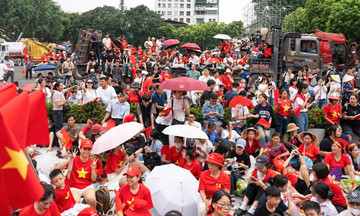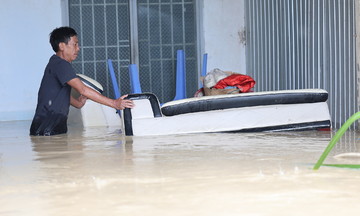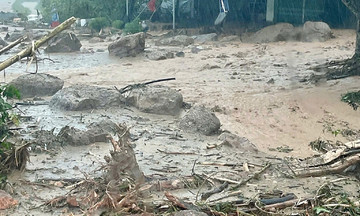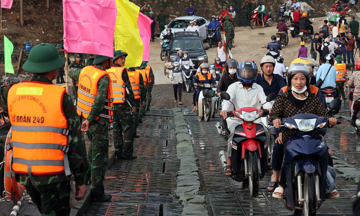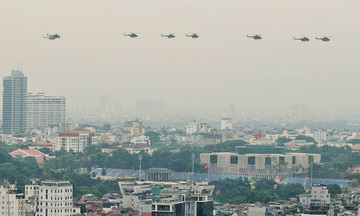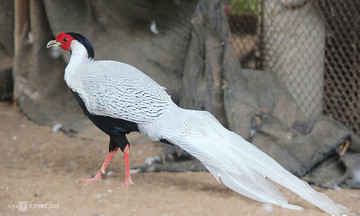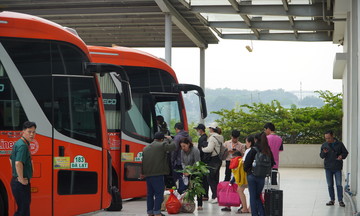On October 3, 2016, Bob Connor, an American, commented on an aerial photo of Bien Hoa Airbase in Dong Nai province posted on architect Nguyen Xuan Thang’s personal website, "If you look up the road on this map of the airbase, then turn right, there's a bunker, called Hill 10. A fierce battle took place there on 15/1/1968. The enemy left 153 bodies and two days later they had to bury them on the runway. Thinking back after nearly 50 years, I still shudder..."
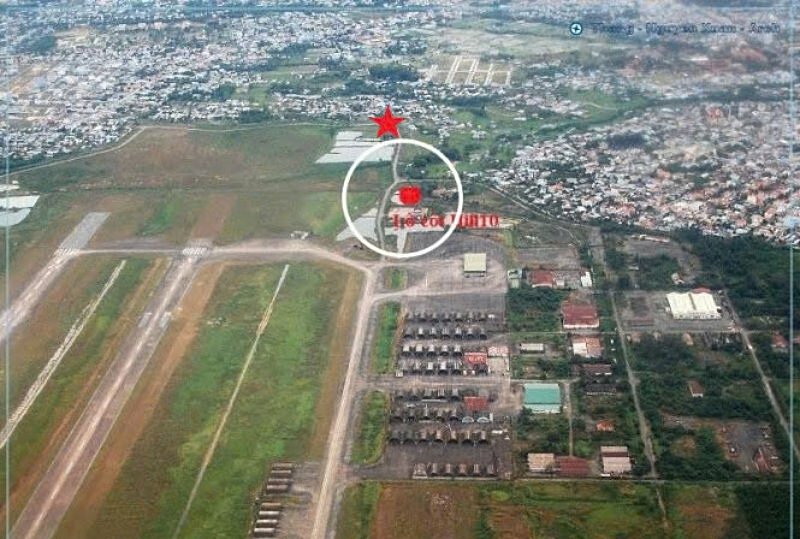 |
The aerial photo of Bien Hoa Airbase posted by Thang online, with the burial site circled in red by Bob Connor, later located at the star. Photo courtesy of the subject |
The aerial photo of Bien Hoa Airbase posted by Thang online, with the burial site circled in red by Bob Connor, later located at the star. Photo courtesy of the subject
The photo was among many aerial images Thang, 52, from Ho Chi Minh City, had collected and posted online 10 years prior. With the intuition of someone who had been searching for the remains of fallen soldiers for 16 years, Thang discussed the comment with Che Trung Hieu, a Hero of the People's Armed Forces, who had extensive knowledge of the war and was fluent in English. They contacted Connor via the email address he had left on the site.
Through email exchanges, Connor revealed he was a former sergeant stationed at Bien Hoa Airbase. He not only marked the location of the burial pit on the aerial photo but also connected Thang with the flight commander, Captain Martin E. Strones, who was present on 15/1 and 16/1/1968, when the Vietnamese soldiers were buried.
The information was relayed to Colonel Mai Xuan Chien, Deputy Political Commissar of the Dong Nai Provincial Military Command. Further email exchanges confirmed that Connor and Strones would soon visit Vietnam to pinpoint the burial sites.
Less than six months later, on 17/4/2017, the two arrived in Bien Hoa. At the exact location marked by Connor on the aerial photo, search teams discovered a mass grave containing the remains of 150 soldiers from Battalion 1, Battalion 2 of Regiment 4, Division 5, and the Bien Hoa Special Forces Company, who died during the 1968 Tet Offensive.
The discovery at Bien Hoa Airbase marked a turning point for Thang in using aerial photography to locate wartime mass graves.
His journey began in early 2000, when, at his mother’s request, the then 27-year-old Thang embarked on a mission to find the remains of his uncle. The only clue was that his uncle died in Quang Nam province in 1972 at the age of 20.
With scant information and fragmented accounts, Thang searched countless cemeteries, ultimately only identifying the general area where his uncle perished. Although his mother’s request was only half-fulfilled, the process connected him with eyewitness accounts that revealed many fallen soldiers remained unfound. They were somewhere, beneath the earth, waiting to be discovered.
Initially, Thang gathered eyewitness accounts, historical data about battles, and lists of soldiers from military units, compiling the information and submitting it to the authorities. The weakness of these files was their qualitative nature; eyewitness accounts, often distorted by time, made search efforts hesitant. However, after the Bien Hoa Airbase discovery, Thang realized aerial photographs provided irrefutable and objective evidence, unlike fallible human memory.
 |
Nguyen Xuan Thang (far right) during a search for fallen soldiers in An Hoa, formerly part of Quang Nam. Photo courtesy of the subject |
Nguyen Xuan Thang (far right) during a search for fallen soldiers in An Hoa, formerly part of Quang Nam. Photo courtesy of the subject
With his knowledge and passion for photography, Thang began searching for wartime aerial photos of Vietnam. He joined websites, blogs, and forums, seeking images from US veterans, especially pilots. He downloaded all free images and willingly paid for copyrighted ones.
According to Thang, the US possesses a vast archive of aerial photographs taken by strategic reconnaissance aircraft before, during, and after battles. These images are invaluable due to the wealth of information they contain. After the Bien Hoa Airbase event, Connor and Strones provided enthusiastic support. They not only assisted in the search but also connected Thang with other US veterans, rallying support.
"Once, I visited the US, and a veteran drove over 600 km through the snow to give me photographs. Many times, I felt uneasy about having to pay tens of USD for photos, but they would laugh and say it was like buying them a beer," Thang shared. Thanks to the assistance of former adversaries, Thang's database now contains tens of thousands of aerial photographs and maps, focusing on locating mass graves resulting from battles.
Once acquired, the photos require processing. This involves combining technical skills, technology, historical knowledge, and eyewitness accounts. If the terrain has significantly changed, Thang overlays images from different periods to pinpoint the burial sites. Multiple eyewitness accounts are preferred to compensate for discrepancies over time.
When the data reaches a reliability and compatibility level of over 50%, Thang connects with authorities and search teams. This is a race against time, as construction projects can alter terrain, eyewitnesses can pass away, and families continue to wait. To date, approximately 600 fallen soldiers have been found in mass graves across various battlefields, thanks to the data provided by Thang and his colleagues. However, compared to the number of collected files, this represents only 20-30%—"a very small and distressing number."
"Sometimes, it takes years to acquire a needed aerial photo, and by then, the eyewitness has passed away," Thang recounted. In 2017, a soldier from the former Saigon government contacted him about a mass grave from the 1966 Thao River battle in Trang Bang, Tay Ninh province. The grave was near an intersection, but the terrain had completely changed.
Nearly three years later, Thang found an aerial photo of the area, but the soldier had succumbed to Covid-19. The photo revealed the burial site was now under a house, with a small shrine built on top. Without an eyewitness, Thang handed the file over to the authorities.
According to Thang, proposing excavation requires careful consideration. Mistakes can impact both the emotional well-being and livelihood of residents. Often, those making the decision to search risk their political careers due to the cost and complexity involved.
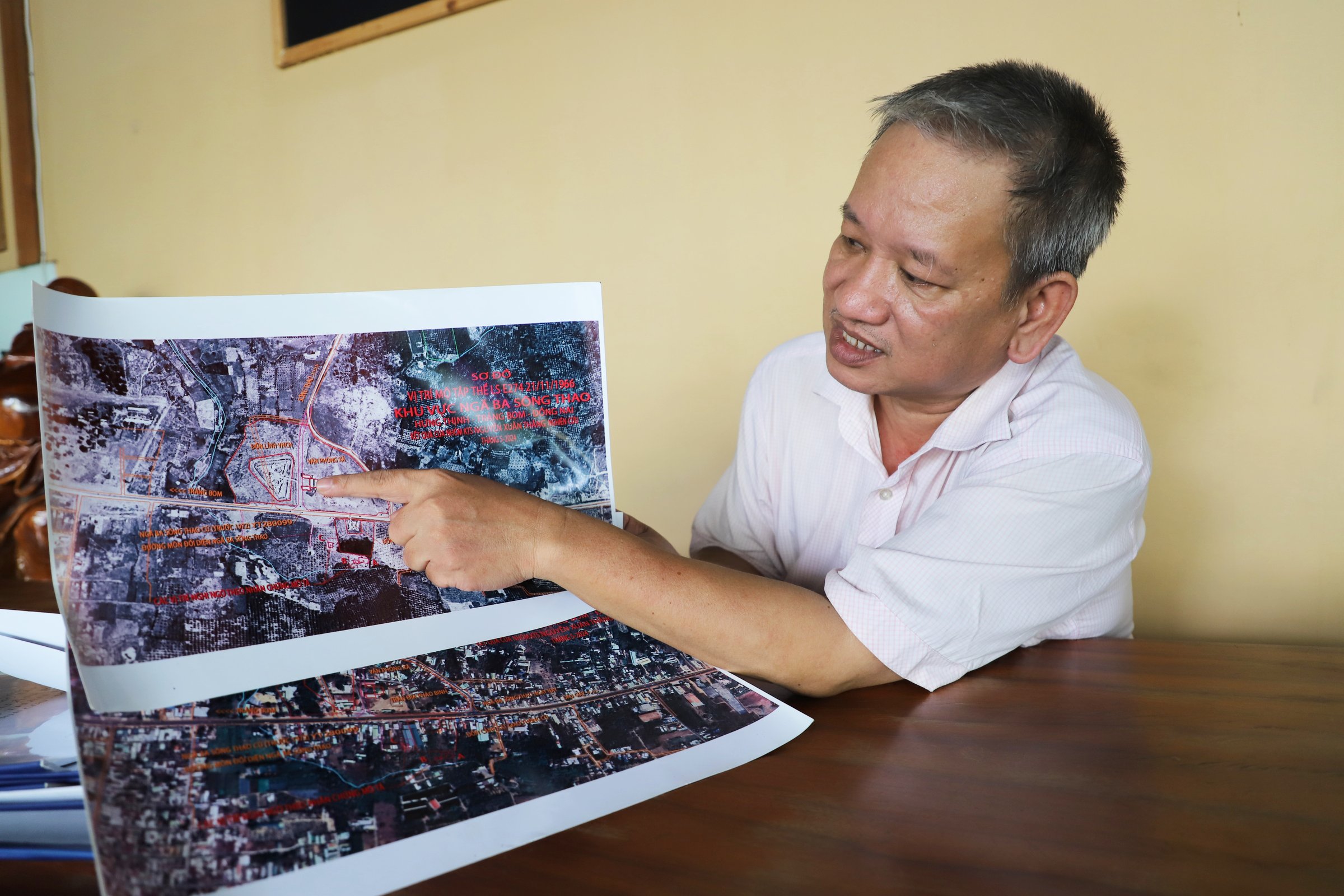 |
Nguyen Xuan Thang with two aerial photographs, before and after, of the suspected mass grave location from the Thao River battle in Trang Bang, Tay Ninh. Photo: Le Tuyet |
Nguyen Xuan Thang with two aerial photographs, before and after, of the suspected mass grave location from the Thao River battle in Trang Bang, Tay Ninh. Photo: Le Tuyet
"Some cases cause great distress for the fallen, their families, and the search teams," Thang shared. One example is a file on a mass grave from a battle on 23/2/1969 at the Loc Ninh base, where soldiers from the 429th Special Forces Regiment perished. Binh Duong and Binh Phuoc provinces have organized two searches, expending considerable effort, but without success.
Colonel Mai Xuan Chien, who collaborated with Thang from the Bien Hoa Airbase discovery onwards, stated that "not everyone, even within the field, can do what Thang does." As a private citizen, Thang willingly sacrifices his work, finances, and family time to pursue any lead.
According to Chien, Thang and Lam Hong Tien, a civil engineer from Hanoi, have provided valuable information in locating mass graves. Thang and his associates have pioneered a new approach to searching for the remains of fallen soldiers, combining US and Vietnamese data, incorporating eyewitness accounts from former adversaries, and leveraging the accuracy of historical aerial photography.
After nearly a decade of quietly searching for information on mass graves, just before the 78th anniversary of War Invalids and Martyrs' Day, Thang and Tien met with Deputy Prime Minister Nguyen Hoa Binh to share their journey. "The government leaders listened attentively, and I feel hopeful that the path home for the fallen soldiers will be smoother," Thang said. He affirmed, "As long as there are leads and people to find, I will continue this work."
Le Tuyet





